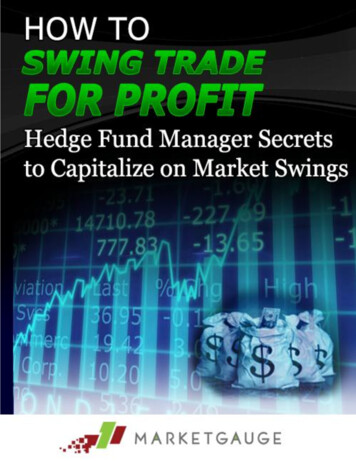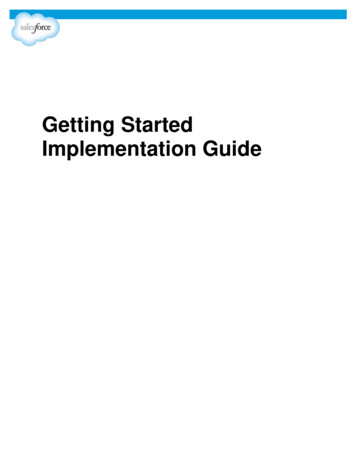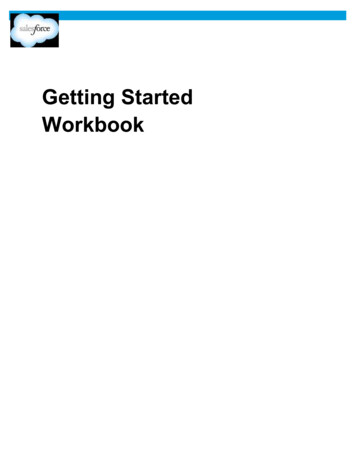
Transcription
Getting StartedMarketGauge has been helping professional trading institutions and individual activetraders trade more efficiently and profitably since 1997. We hope this report improvesyour profitability immediately.The objective of this report and the information that follows it is to accelerate the time ittakes you to reach the level of swing trading expertise that enables you to achievefinancial freedom and practice worry free trading.What Is Swing Trading?Swing trading is a style of trading that profits from the movement of prices over a coupleof days to a few months. The time frame for holding a swing trade is shorter than a buyand hold investor, and longer than a day trader who doesn’t want to hold a position overnight.Markets are constantly moving both up and down, even when they are trending. Swingtraders catch the burst of price movements that occur within larger trends or wider priceranges. A typical swing trader likes to take profits after a market has made a move andbefore it reverses. A typical swing trade may last a couple days to several weeks.One of the most attractive characteristics of swing trading is that it can be very profitablein bull markets, bear markets and even in trendless, range bound markets!Overcome Four Common Challenges To Profiting In The MarketsWhether you’re trading to provide your sole source of income, a secondary incomestream, or a way to build your retirement nest egg - you’ll face a variety of challengesand obstacles.Some obstacles you can control, others you can’t influence at all, but all obstacles canbe overcome!The best way to overcome trading challenges is to recognize them upfront and have aplan to conquer them.Below are four common trading challenges that many traders face:1. You can no longer rely on a buy and hold approach to stocks.Since 2001 the markets have seen extreme volatility, with little benefit for the buyand hold investor. If you bought the S&P 500 at the 2001 highs, your“investment” was underwater until early 2013. Even more unsettling is the factthat during this 13 year period, the S&P 500 saw its value cut in half, not once,but twice!
2. Big losses can ruin your savings.It only takes a few big losses to set you back years in your savings, and if youare not careful, they can wipe out an account. There is no reason for big losses ifyou trade with professional entry and exit rules.3. A small account size can limit your trading options, BUT this does notprevent you from making money by trading or building your account size up tothe size you desire. You can swing trade with as little as a few thousand dollars.Please don’t expect to turn a few thousand dollars into a million dollar account ina short amount of time, but don’t assume you can’t make money either. The bestapproach to success in trading is to have the mindset that you will grow richslowly and with consistent returns – no huge losses, and no outrageously riskytrades that attempt to make a killing over night.4. You don’t need to commit to becoming a full-time trader.You can earn extra income or build your savings and assets as a part-time swingtrader. And “part-time” can mean focusing on the markets only during a certaintime of the day (i.e. the morning), or only trading on days when you’re available.As a part-time trader you can trade short multi-day trends, or longer multi-weektrends that require only a few minutes a day to manage your positions.We’ve prepared this report to put you on the path toward overcoming all of thesecommon trading challenges and lead you to the goal of financial freedom andworry free trading.MarketGauge.com3
Rule #1:Trade the Current Market Phase“Trade With the Wind at Your Back”This rule is how you overcome the “buy and hold” obstacle. Understandingmarket phases enables you to take advantage of trends that are in your favor, andavoid the risk of holding positions when the trend is against you.We trade when the opportunities are right, and stay away from the market when the riskis high.Stocks and markets obviously don’t go straight up or straight down continuously. Theycycle up and down in what we call “Market Phases.” This rule keeps the wind at yourback by trading with the primary trend in the market.The most obvious application of this concept is that traders want to be long during theup phases, short during the down phases, and out of the market during choppy periods.When a strong up or down phase can be reliably identified you have a real edge in themarket. For most traders, however, it’s not easy to reliably know when a market is in astrong trending phase.And if you have tried to systematically define which phase a market is in, you probablyfound that there are more than two phases - up and down. Let us help.Rule #1 is to trade in the direction of the market phase. This gives you a distinctadvantage as you become a more sophisticated trader, you will develop specific tradingstrategies that do best in specific market phases.In developing our trading strategies, we’ve done a lot of research and back testing tofigure out a simple and effective method of knowing whether the market is in an upphase, down phase, or a transitional phase.Start Simple - Assume There are Only 3 Market PhasesBelow is a daily chart of the S&P 500 (as represented by the “SPY” ETF). The timeperiod of this chart was specifically chosen because the trends shift many times makingit a challenging period.The daily bars are colored so that the days of the Bullish Market Phase are green andBearish Market Phase days are red. White daily bars are transitional market conditionswhere your market bias would be neutral. The transitional period will be explained later.MarketGauge.com4
Daily Chart of The “SPY” ETF with 3 Phases:The Benefits of Phases Are HUGE, Yet Many Traders Ignore This!Trading from the long side is MUCH EASIER when the market is in a bullish phase!Shorting is easier when the market is in a bearish phase. Doing the opposite (i.e. goinglong in a bearish phase) is extremely risky, but many traders make this costly mistakeconstantly!If you don’t have a simple, systematic method to determine the current market phase,stop trading until you get one. This applies to market indexes, ETF’s, and stocks.Successful traders know what the current market phase is, and they use a strategy thattakes advantage of the characteristics of that market phase.You do not need a strategy for every phase. Instead you need a market in the phaseyou’re good at trading. You will be best at trading strategies that match your personality,or your natural preference to be bullish, bearish, long-term, short-term, etc. If you onlylike to go long, there are plenty of opportunities to find market trends that are bullish.Some of these opportunities are ETF’s that go up because the market is going down.How Many Market Phases Are There? Two, Four, Six?So far we’ve shown how you can make your life easier by taking these first steps:o Focus on just three market phases – bullish, bearish and transitional.o Only trade when the phase is clear.o Focus your trading on markets in the phase that is in line with your personality andstrategy.MarketGauge.com5
MarketGauge has created a systematic approach to determining the strength anddirection of the market which categorizes the market into more than 2 market phases. Itis common to think of the markets as having 4 market phases: accumulation(bottoming), bullish, distribution (topping), and bearish.Our Swing Trading model identifies 6 different market phases as illustrated below:Six Market Phases of Stocks, Indexes, and ETFsThe Most Powerful Time to Catch a Market PhaseWe encourage you to look at market activity as having six different market phasesbecause one of the most powerful times to focus on a stock, index or ETF is when it isexperiencing a phase change!Don’t try to pick absolute tops and bottoms, but do know when the market phase isshifting. This is when trends begin and/or accelerate! The easiest way to reliably identifythese powerful shifts in trend is through a simple and systematic approach to trendanalysis.Look at the chart below to see the power of viewing the market with 6 phases. This isthe same daily chart of the S&P 500 (as represented by the “SPY” ETF) shown above,but this time the days that were previously white and “transitional” are now moreprecisely defined as warning (yellow), distribution (magenta), recovery (light blue), andaccumulation (dark blue).MarketGauge.com6
Daily Chart of the “SPY” ETF with 6 Phases:Look At How Powerful It Is to Know the Market Phase Is ChangingLook at how turning to green (“bullish”) means the bulls are in control, and the bearstake over when its red, and how clearly you can see transitions coming.Notice how the yellow (“warning”) days gave you a heads up of volatile downmagenta (“distribution”) days to come.Look at how much lead time you had to be forewarned of trouble before the brutalred (“bearish”) days set in.Notice the result of a light blue (“recovery”) phase turned red (“bearish”). Here’s onenuance of phases - the fact that the recovery phase of April and May ‘08 neverprogressed into an accumulation phase made its deterioration into a bearish phasean extremely dangerous bearish phase.These colored bars representing the phases are not subjectively drawn. You don’t needspecial software to know the market phase. They are based on simple rules andformulas using the 50 and 200 day moving averages. Keep your rules simple!These market phases are not limited to market indexes – they hold true for stocksand ETFs too.MarketGauge.com7
Below you’ll find more examples of how the market phases keep you on the right side ofthe major trends.SPY: March 2008 – October 2009SPY: April 2009 – Oct 2010MarketGauge.com8
SPY: Oct 2011 - 2013MarketGauge.com9
Rule #2:Timing Your Entry:“Be In the Right Place at the Right Time”We call this principle “The rule of being in the right place at the right time - timing iseverything.”Good timing is a result of combining the potential momentum from multiple timeframes, with quality entry tactics. This rule is where big opportunities are created!This rule covers the area of trading that most traders spend all their efforts on – entries.However, despite the huge focus on this area, huge mistakes are made.Your Holy Grail IndicatorIf you are going to develop a good trading system, the first step is to STOP LOOKINGfor “the perfect entry indicator.” It does not exist. Even good stocks fail, and you don’tneed a perfect indicator to be a successful trader. You need a simple, repeatable,systematic approach to entering (and exiting) the market.The “right place at the right time” will not be the same time and place for every trader,because different trading styles, risk tolerances, and profit objectives will have their ownideal entry point.To put yourself in the right place at the right time, you have to execute good qualityentries, in the right market conditions.What is a “Good Quality” Entry?Good quality entries take into consideration the bigger goal – the system. Don’t focuson perfecting individual trades. Focus on building entries that deliver consistentresults over a large number of trades – systems lead to success, not individualtrades. Here are some guidelines to follow when you define your entries.Characteristics of Good Entries:1. Easy to identify and execute: Your entry criteria should be as simple aspossible. If your entry rules are too difficult to identify or act upon, then you won’tuse them consistently, and that renders them completely ineffective!2. Easy to repeat consistently: Success in trading comes when you have anapproach, or system that you can execute with consistency. If your criteria aresubject to a lot of interpretation you will not be able to identify the same marketcondition that constitutes a consistent entry. This reinforces the importance ofsimplicity.3. Complementary with the trading personality of your market: The tradingpersonality of your market is the way in which a stock trades.MarketGauge.com10
The best way to illustrate this point is with this example. If a stock generallyexperiences a daily trading range of 10 and has a typical bid-ask spread of .50to .75 (i.e. GOOG when it was hot) your entry and exit rules must take thatvolatility and large spread into account. This is not a trading personality that isappropriate for stop loss criteria of 0.25 below your entry price. Instead youshould have stop-loss criteria that enable the stock to trade with its normal levelof volatility immediately after your entry without getting stopped out.4. Complementary with the premise of your trade: When you enter a trade youshould have a plan. You should also have an expectation of what the trade coulddo if it works, and what it might do if it doesn’t work. Therefore, the quality of yourentry is related to where you intend to place your protective stop. A good entrywill enable you to stay in the trade until the conditions of the trade “not working”are met.Identifying The Right Market Conditions For Your Quality EntriesIn Rule #1 we discussed using Market Phases to identify the best time to catch bigtrades based on established trends and major trend transition periods. Now it’s time toidentify low risk entry points which are consistent with the prevailing phase condition.At MarketGauge we identify low risk,big opportunity trades by looking forspecific short-term price patterns.One of the best short-term pricepatterns for new and experiencedswing traders is a retracement overseveral days to a significant supportlevel. Once the market is near thissupport level we will look forconsolidation and reversal patternsthat indicate that main trend isresuming.Chart 1: Goldman Sachs (GS) daily chartAn example of this would be amarket in a Bullish Phase that hasretraced back to the 10-day movingaverage as support. After a trendingmarket breaks below the 10-day moving average on a closing b
Swing trading is a style of trading that profits from the movement of prices over a couple of days to a few months. The time frame for holding a swing trade is shorter than a buy and hold investor, and longer than a day trader who doesn’t want to hold a position over night. Markets are constantly moving both up and down, even when they are trending. Swing traders catch the burst of price .











